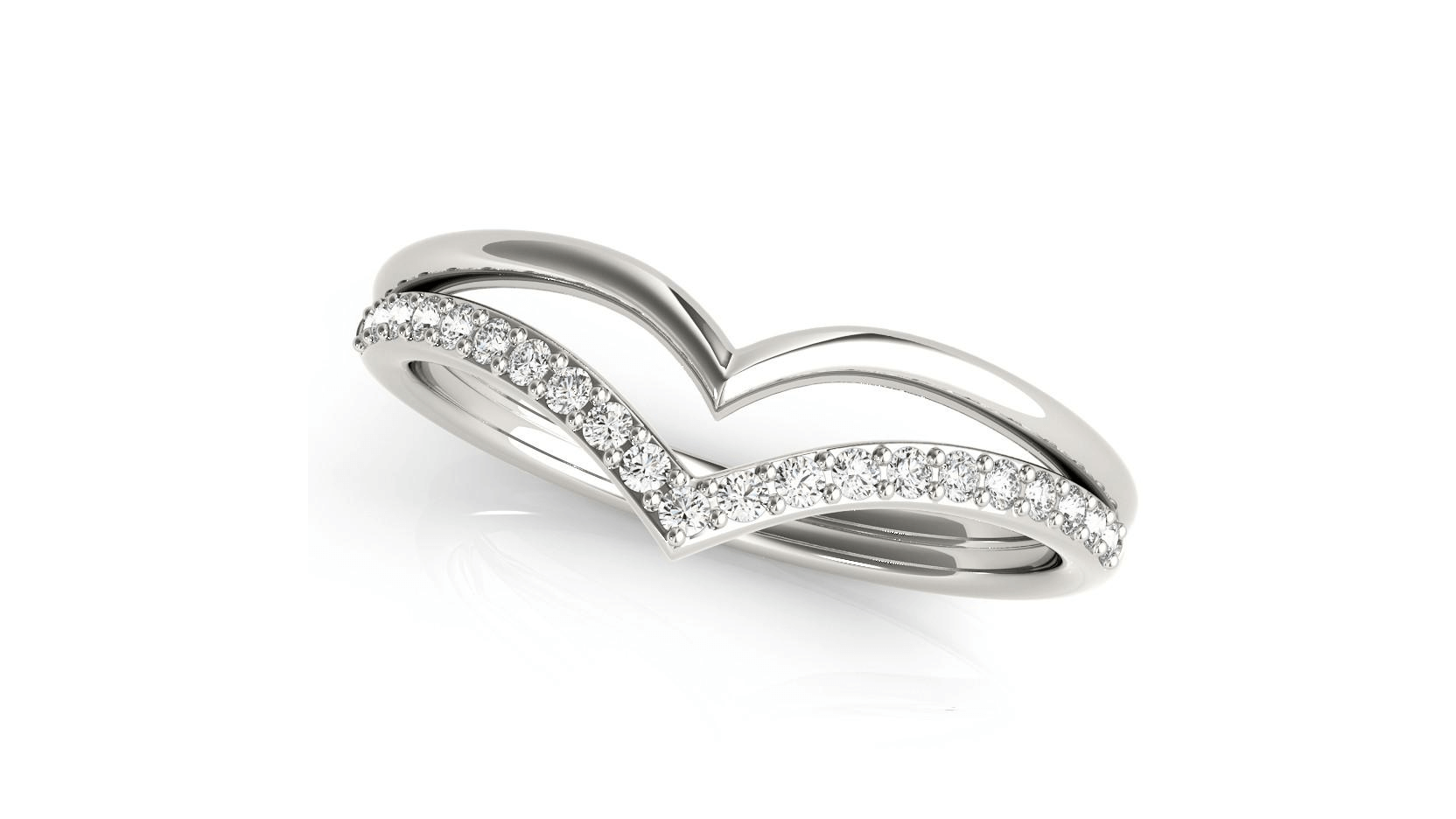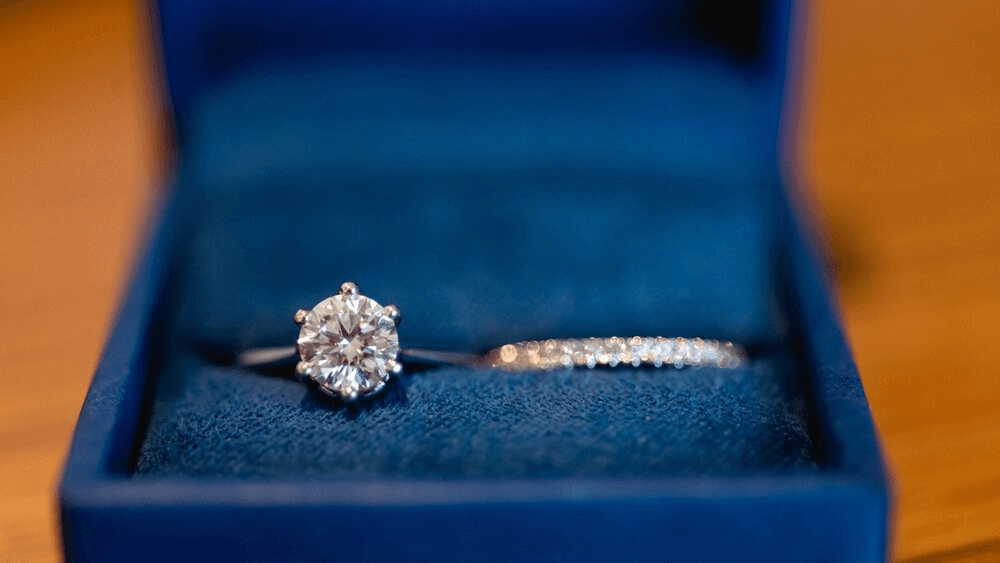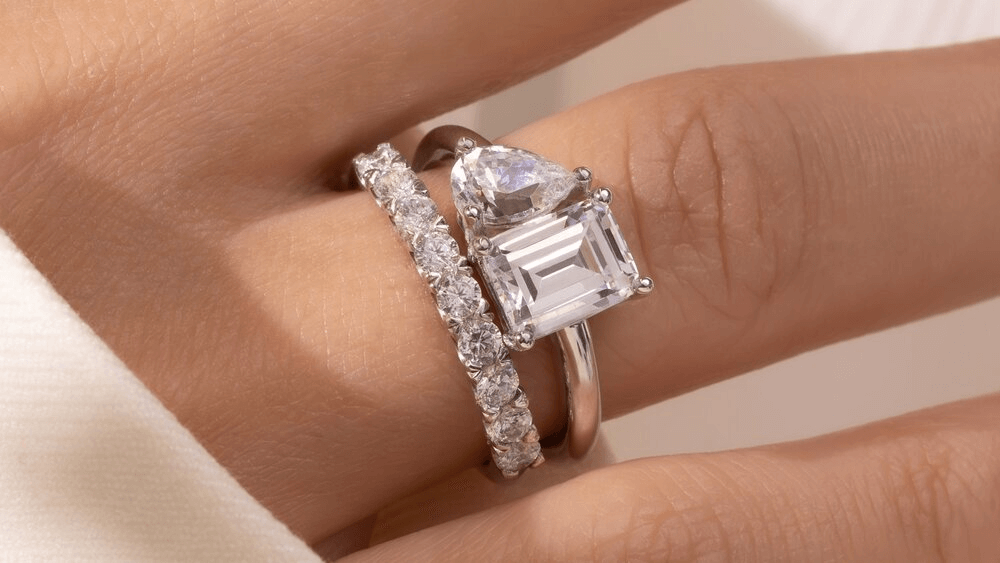Dazzling Duo: Halo Rings & Wedding Bands Explained

By Gary A.

Edited by Olivia H.
Published Aug 17, 2021
Edited on Mar 31, 2025
When it comes to selecting the perfect match, wedding bands for halo engagement rings require a little extra consideration to ensure both rings work together in harmony while highlighting the beauty of the halo setting.

Navigate This Guide:
- 11 Quick Tips for Choosing the Perfect Wedding Band for Your Halo Engagement Ring
- Introduction
- Choosing the Right Wedding Band for Your Halo Ring: Factors to Consider
- Straight Bands with Halo Rings: Compatibility Guide
- Halo Wedding Sets: A Comprehensive Solution
- Exploring Wedding Band Styles
- Creative Design Considerations for Wedding Bands
- Our Expert Take
- 7 FAQs
Before we dive deeper into the specifics, here are some practical tips to help guide your decision-making process:
11 Quick Tips for Choosing the Perfect Wedding Band for Your Halo Engagement Ring
- Tip 1: Understanding Halo Ring Settings: Before diving into the selection of a wedding band, it’s essential to understand the specific features of your halo engagement ring. Halo settings, known for their central stone encircled by smaller diamonds, create a distinctive and sparkling appearance. This setting can influence the type of wedding band that pairs best with it.
- Tip 2: Matching the Band to the Halo Contour: Ensure that the wedding band aligns with the halo’s contour. This is crucial to prevent the band from overshadowing the engagement ring or causing any discomfort.
- Tip 3: Consider a Curved Band: For rings with a pronounced halo, a curved wedding band might nestle better against the engagement ring. This style complements the halo without competing for attention.
- Tip 4: Coordinating the Band Style with the Halo: Choose a wedding band that echoes the design elements of the halo. For instance, if your halo ring features pavé diamonds, consider a wedding band with similar detailing.
- Tip 5: Metal Harmony: Ensure the metal of the wedding band matches or complements the engagement ring. This creates a cohesive look, especially important in halo settings where the band is more visible.
- Tip 6: Balancing Width and Proportions: Select a wedding band that balances well with the halo ring in terms of width. A band too wide or too narrow can throw off the symmetry and aesthetic of the halo setting.
- Tip 7: Proportionate Embellishments: If choosing a wedding band with additional embellishments, ensure they are proportionate to the halo ring. Overly elaborate bands can detract from the halo’s elegance.
- Tip 8: Considering Lifestyle and Comfort: Your daily activities should influence the choice of your wedding band. If you lead an active lifestyle, a more secure and less intricate band might be more practical.
- Tip 9: Comfort is Key: Since the wedding band will be worn daily, prioritize comfort. The band should not only look good with the halo ring but also feel comfortable on your finger.
- Tip 10: Finalizing Your Choice: Take time to visually assess how the wedding band complements the halo engagement ring. They should create a harmonious and pleasing look when worn together.
- Tip 11: Personal Style: Ultimately, your personal style should guide your choice. The wedding band, while needing to complement the halo ring, should also reflect your individual taste and preference.
Now that you’ve got these practical tips, use Jeweler AI below to find the perfect engagement ring that suits your style and budget:
Introduction
It’s safe to say that the halo setting is one of the most popular styles for engagement rings today – and has been for quite some time.
Their ability to look both classic and modern stems from the precise, orderly placement of the accent stones, which follow the line of the center diamond faithfully. While this pretty ornate decoration around the center stone is evocative of the more traditional ring designs, that clean outer line – whether rounded or square or any other shape – creates a modern, streamlined look that so many ring buyers (and wearers) find impossible to turn down.
Regardless, when it comes time to begin shopping for a wedding band, the added bulk of the halo can make it very difficult to track down a design that will sit comfortably alongside the engagement ring, without being overshadowed or, worse still, rubbing or clashing against it and causing damage to both rings.
Fortunately, there are plenty of ways around this – and they’re all as beautiful as they are wearable.
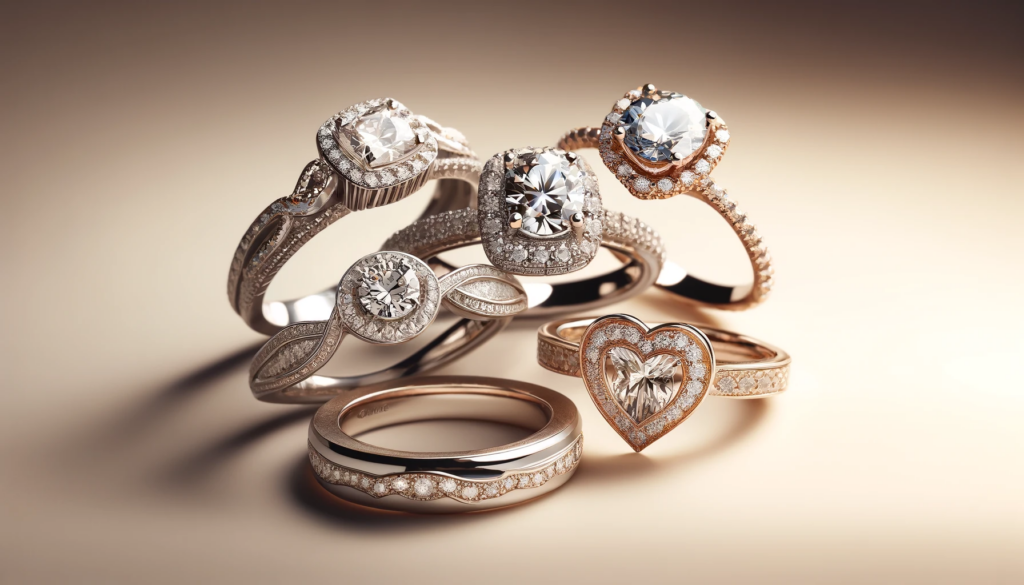
Choosing the Right Wedding Band for Your Halo Ring: Factors to Consider
You can’t fit a square peg in a round hole, and you definitely can’t fit a new band alongside a halo without making a few modifications.
What you need is a solution for when you try on wedding bands at the jewelry store, only to find that the halo setting on their engagement ring overlaps the new band, either hiding it or creating an uncomfortable clash between the two.
Contoured Wedding Bands: A Closer Look
This is why the contoured band is such a good option. Perfect for those wearing halo engagement rings, these bands feature a strategically placed curve, specifically designed to accommodate the unique outer shape of your engagement ring.
When it comes to fitting comfortably with the wedding band, by disrupting the circular shape of a traditional wedding band, and creating a silhouette that faithfully traces the profile of the engagement ring, contoured bands ensure that brides avoid any of that discomfort, with the two pieces slipping together nicely.
A contour can also be created to accommodate any setting shape, though some – for instance, the flower setting – can be much trickier, and will require more time and skill from the jeweler creating it. You may need a square, oval, or heart and, for that, a pretty unique design.
One disadvantage to this style of wedding band is that, on its own, it may look a little strange. If you’re designing your wedding ring around a halo, you may feel as though you need to wear that engagement ring all of the time. If this is something you’d rather avoid, consider a chevron wedding band…
Chevron Wedding Bands and Their Bold Statement
This is a ring that features a ‘V’ shape, designed to accommodate a more prominent setting, such as a halo.
They are pretty similar to contoured wedding bands, and follow the same principle, although the style is totally different, and most brides will have a clear favorite when shown a sample of each one.
The chevron is generally bolder than the gentle curve of a contour ring, as it comes to a definitive point rather than following the exact shape of the halo.
These rings are also known as wishbone rings. Just like contoured wedding bands, the main downside is the fact that they may not look ‘right’ if they’re ever worn without the engagement ring.
Ring Guards: Protection Meets Elegance
Another option is a ring guard, which plays two major roles. First off, it’s an alternative to the traditional wedding band, and is placed on the finger during the wedding ceremony. Secondly, it’s there to create a more robust barrier around the engagement ring, and protect it from damage.
Ring guards are created in a single piece, though they will be worn on either side of the engagement ring. A small groove between two conjoined bands ‘hugs’ the band of the engagement ring, and keeps it secure.
These pieces can be highly decorative, and add further decoration to the original design of the engagement ring, or they can be plain and simple.
They tend to be created as bespoke pieces, in order to create the perfect shape to fit the silhouette of the engagement ring. For this reason, they’re a highly practical and popular choice for those looking for more protective wedding bands for halo engagement rings.
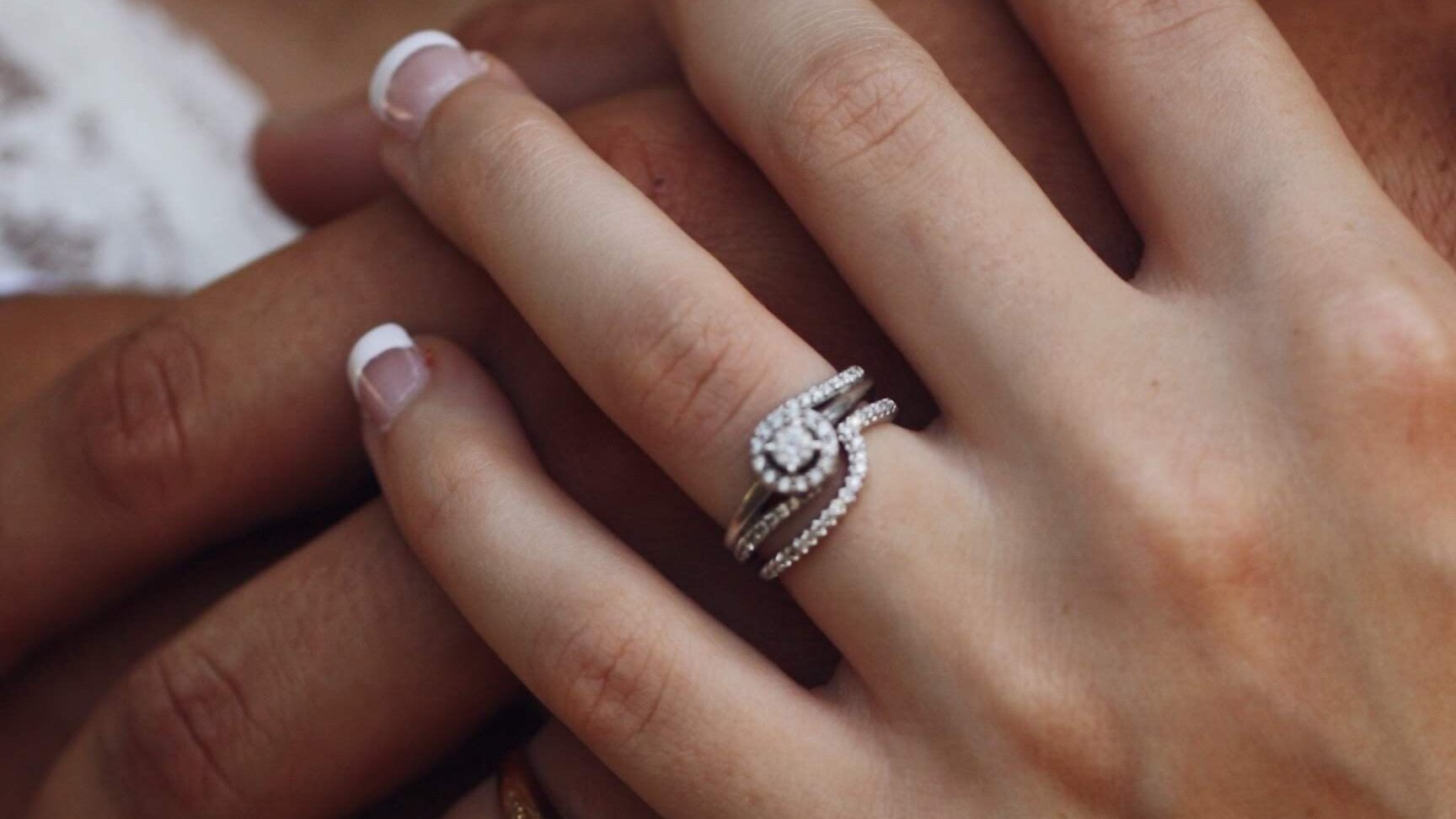
Straight Bands with Halo Rings: Compatibility Guide
Some halo settings are raised high enough off the finger to leave a space for the wedding band to slide comfortably underneath the diamond’s overhand. In this instance, you might opt for a flat or micro pavé wedding band.
Just because many women choose to add a notch, chevron, or curve into their band, doesn’t mean this is the only option. Halos that sit higher on the finger, such as those supported by a cathedral setting, won’t clash with a wedding band.
If your halo setting is a little closer to your actual finger, however, you’ll probably want to set aside more time to examine more options in order to find the one that will sit flush with the finger.
Keep in mind that this will mean at least a part of your wedding band will be concealed by the halo. There’s nothing wrong with this being the case, but it’s a personal choice, and not worth making if you’re going to end up disappointed over the fact that your wedding band is being ‘pushed down’ by your engagement ring.
Halo Wedding Sets: A Comprehensive Solution
A wedding set includes two coordinating rings for the bride – an engagement ring, and a wedding band – as well as a wedding band for the groom. In a halo set, the bride’s two rings will be specifically designed to accommodate the halo setting on her engagement ring to avoid any setbacks during the run up to the wedding.
This is just a simpler way of ensuring that, on the wedding day, her new band will coordinate with her engagement ring – both in terms of appearance and, perhaps more importantly, shape.
As we mentioned above, you can easily purchase a contoured wedding band separately, and don’t have to pay for the full set upfront – but, if you’re confident in choosing your bride-to-be’s wedding ring too, a wedding or bridal set is a great choice for avoiding a potentially long search for separate wedding bands for halo engagement rings.
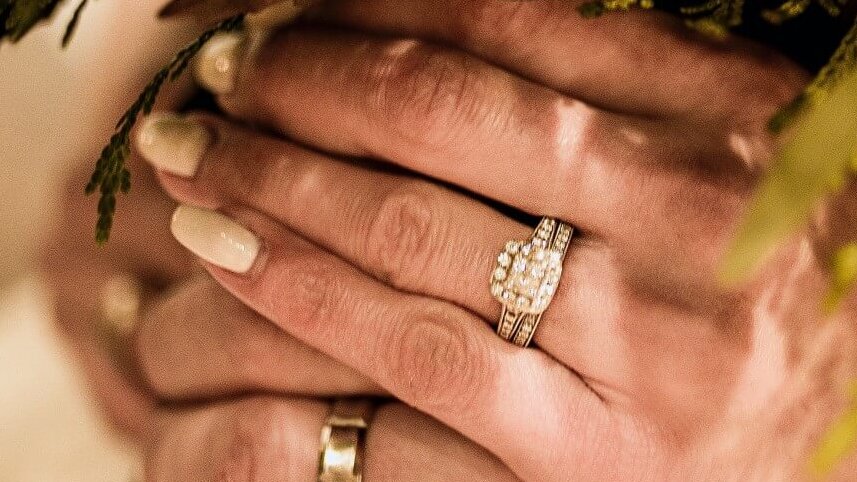
Exploring Wedding Band Styles
There’s no rule stating that a ring has to be a perfect circle. Some people see it as a representation of endless love, but many couples prefer to go for what they love, and what feels comfortable, instead of sticking to any particular tradition.
Remember that a wedding ring represents your commitment to your spouse, not your ability to adhere to tradition.
These days, wedding rings can feature contours, chevrons, notches, and asymmetric curves, whether for practical purposes (such as accommodating a halo engagement ring) or simply out of a love for embracing new design trends, and going against the grain.
You’re the one who’s going to be wearing this ring for the rest of your life, so don’t limit your choices.
Creative Design Considerations for Wedding Bands
One of the most significant trends today is brides soldering their wedding and engagement ring together to make one big piece. But this is a big decision to make. While soldering your wedding and engagement rings together after the wedding has plenty of benefits, there are still a couple downsides you should be aware of before making up your mind.
For some brides, wearing their wedding and engagement rings side by side is not as comfortable as they’d expected, even if they chose them specifically as a coordinating pair. The solution – or one of the solutions – to this issue is to have both rings soldered together, meaning that they can’t slide around separate from one another or cause any pinching on the finger.
What’s more, preventing the two rings from rubbing together will mean that each one will experience less wear and tear from the other – and you’ll spend less time flipping a wonky diamond back into place.
Even so, soldering your engagement ring makes it much harder for you to eventually pass it down, as it seems pretty unlikely you’ll want to pass your wedding band down along with it. Separation is possible down the line, but it does put the two rings at risk of some damage. This process should be carried out by a highly experienced jeweler.
Our Expert Take
Halo engagement rings are a classic setting style for any diamond cut or size, and they ensure a great amount of sparkle to compliment the center stone.
Some people feel deterred from wearing a halo engagement ring, despite loving the design, just because they have no idea how they’ll wear it day in and day out alongside their wedding band.
Thankfully, you don’t have to sacrifice your perfect ring for comfort – the two aren’t mutually exclusive. In fact, you can find cohesion no matter what shape you are working with – it may just take a little extra creativity to get it perfect.
7 FAQs
- Does a halo setting make the ring look bigger?
- Yes, the accent diamonds in a halo setting can create the illusion of a larger center stone, giving your ring a more substantial appearance.
- Are halo engagement rings dated?
- Not at all. Despite their long history, halo engagement rings remain a popular and stylish choice, offering a blend of vintage charm and modern flair.
- How do I choose a halo ring? Choosing a halo ring involves considering various factors like the shape of the diamond, the metal type, and personal style preferences. Exploring different designs and trying on various rings can help you find the one that suits you best.
- When did halo rings become popular?
- Halo rings first gained popularity in the late 18th century and have maintained their status as a classic and elegant choice for engagement rings since then.
- What are the most popular diamond shapes for halo engagement rings?
- Popular diamond shapes for halo engagement rings include oval, cushion cut, round, princess cut, and emerald cut. Each shape offers a unique appeal and complements the halo setting in different ways.
- What are the pros and cons of a halo setting?
- Pros: Adds more sparkle, can make the center stone appear larger, and offers protection to the center diamond.
- Cons: Can be challenging to pair with a wedding band due to its low-sitting halo, may require more maintenance and cleaning, and smaller stones in the halo can dislodge if hit.
- How to care for a halo engagement ring?
- Regular cleaning with warm water and mild dishwashing detergent, gentle scrubbing with a soft-bristled toothbrush, and proper storage are essential. It’s also advisable to avoid harsh chemicals and have the ring inspected and cleaned professionally on a regular basis.
Finding the right wedding band for your halo ring isn’t just about style; it’s about creating harmony between two symbols of your love. Jeweler AI is here to navigate the options out there
FOLLOW-UP GUIDE SERIES

